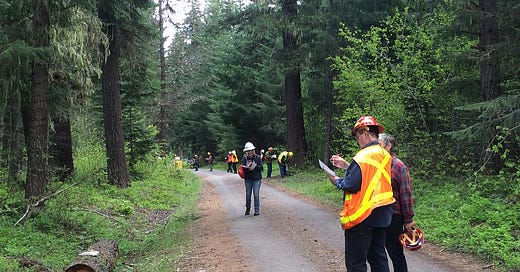Why carbon offsets must be on the table
When we plant trees to replace those removed we start the process over and continue to sequester carbon. Carbon offset reforestation should be our aim.
I work in the HVAC industry where energy conservation has been an emphasis for the last two decades. We have year-over-year reduced the amount of carbon required to heat homes. Not only is there a moral imperative for this conservation, it also lowers energy costs for those who can least afford high energy bills or freezing homes.
I have a clear vantage point into our state’s effectiveness in the efficiency realm. Oregon is doing exceedingly well in energy efficiency measures, incentivizing upgrades, and using the energy sources that we have for good use. The Energy Trust of Oregon was created in 1999 to encourage and incentivize energy upgrades in commercial buildings and residential homes. There may be a smart thermostat on your wall because of this program.
However, while we have worked hard to reduce and alleviate the effects of carbon in our state, the current forest management strategy is reversing that work. Not actively managing our forests is negating the progress done in other areas. The USDA noted that, prior to 2017, yearly wildfires resulted in a loss of carbon equivalent to 11% of the net increase in carbon in the Oregon and Washington region.
Last year, we saw our forests become roaring fuel for fires devastating not just State Park lands, but also homes and communities. Our past strategy and future game plan has been to react quicker. But clearly, better, faster, and more aggressive wildland fire suppression is no way to manage. Our legacy of forest management is charred homes, broken lives, and millions of board feet of carbon thrown back into the sky.
Like a beautiful garden, our forests need to be stewarded. And, in this care, we have a unique opportunity. When we cultivate our forests, taking trees away, to remedy the density and danger, we also forever sequester carbon into whatever product that wood is used to create. When we plant trees to replace those removed we start the process over and continue to sequester carbon. Carbon offset reforestation should be our aim.
The USDA notes that the forests in Oregon and Washington currently store an estimated 2,100 million metric tons (mmt) of carbon accumulating at a rate of 7 mmt per year, or 24% of the carbon emissions of the two states. And younger trees accumulate carbon faster than older trees. Removing trees and planting new ones harnesses this natural process for the good of us and the forests.
The cost associated with tree removal and replanting is far outweighed by the selling of the wood and the reduction in the loss of communities and need for firefighting. This alongside the reborn industry based around a conservation posture for our forest will be a boon for both the state and our ecology. This is far better approach than our current plan of negating the energy work we have done in other areas by waiting for the yearly conflagration.
If you picture in your mind a symbol for our state you likely ponder trees. Our evergreens adorn our hills and mountains. They create the backdrop of our hikes and frame our farms. Our state is green, first and foremost, because of our forests. Look up the recently upgraded roof for the PDX airport. We are proud of our trees, striking in beauty. We should be proud enough to take care of them.
Co-host of the City on a Hill Podcast. He has lived in Oregon for the last 25 years and currently resides in West Linn. Perennial city/county advisory board member. Neighbor.
Photo credit: "2016. Instructor Ellen Goheen (plaid shirt, right). Roadside hazard tree training. Southwest Oregon Forest Insect and Disease Service Center." by USDA Forest Service is marked with CC PDM 1.0






Hi Kevin. This article repeats numerous debunked talking points developed the timber industry to confuse the role logging plays in climate change. The wood products industry creates much higher carbon emissions than forest fires. Logging and replanting forests does not remove more carbon from the atmosphere than leaving trees to grow (here is a great short video from PBS explaining this by Dr Bev Law from Oregon State University: https://www.youtube.com/watch?v=LDdKOmvIKyg). Fun fact, it takes 30 years for a forest in Oregon to return to sequestration after logging. And the notion that logging "locks up" carbon misses the fact that only a small percentage of a harvested tree ends up in a building, and of that, the lifecycle of your average piece of wood in a structure is nothing compared to a tree left standing in the forest, even after a high intensity fire. This article, while apparently well intentioned, unfortunately creates more confusion about the role Oregon's forests can provide for carbon sequestration and climate change resiliency.
Tried to leave a comment, but 360 seems to have erased it. This Estep commentary contains multiple factual misstatements and misinterpretations.